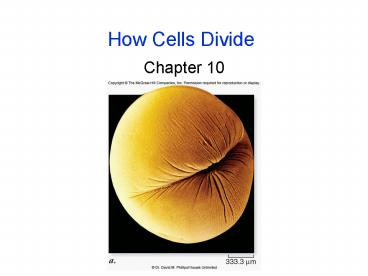How Cells Divide - PowerPoint PPT Presentation
1 / 32
Title:
How Cells Divide
Description:
How Cells Divide Chapter 10 * Bacterial Cell Division Bacteria divide by binary fission. -the single, circular bacterial chromosome is replicated -replication begins ... – PowerPoint PPT presentation
Number of Views:32
Avg rating:3.0/5.0
Title: How Cells Divide
1
How Cells Divide
- Chapter 10
2
Bacterial Cell Division
- Bacteria divide by binary fission.
- -the single, circular bacterial chromosome is
replicated - -replication begins at the origin of replication
and proceeds bidirectionally - -new chromosomes are partitioned to opposite ends
of the cell - -a septum forms to divide the cell into 2 cells
3
(No Transcript)
4
(No Transcript)
5
Eukaryotic Chromosomes
- Eukaryotic chromosomes
- -linear chromsomes
- -every species has a different number of
chromosomes - -composed of chromatin a complex of DNA and
proteins - -heterochromatin not expressed
- -euchromatin expressed regions
6
Eukaryotic Chromosomes
- Chromosomes are very long and must be condensed
to fit within the nucleus. - -nucleosome DNA wrapped around a core of 8
histone proteins - -nucleosomes are spaced 200 nucleotides apart
along the DNA - -further coiling creates the 30-nm fiber or
solenoid
7
Eukaryotic Chromosomes
- The solenoid is further compacted
- -radial loops are held in place by scaffold
proteins - -scaffold of proteins is aided by a complex of
proteins called condensin - karyotype the particular array of chromosomes of
an organism
8
(No Transcript)
9
(No Transcript)
10
(No Transcript)
11
Eukaryotic Chromosomes
- Chromosomes must be replicated before cell
division. - -Replicated chromsomes are connected to each
other at their kinetochores - -cohesin complex of proteins holding replicated
chromosomes together - -sister chromatids 2 copies of the chromosome
within the replicated chromosome
12
(No Transcript)
13
Eukaryotic Cell Cycle
- The eukaryotic cell cycle has 5 main phases
- 1. G1 (gap phase 1)
- 2. S (synthesis)
- 3. G2 (gap phase 2)
- 4. M (mitosis)
- 5. C (cytokinesis)
- The length of a complete cell cycle varies
greatly among cell types.
interphase
14
Interphase
- Interphase is composed of
- G1 (gap phase 1) time of cell growth
- S phase synthesis of DNA (DNA replication)
- - 2 sister chromatids are produced
- G2 (gap phase 2) chromosomes condense
15
Interphase
- Following S phase, the sister chromatids appear
to share a centromere. - In fact, the centromere has been replicated but
the 2 centromeres are held together by cohesin
proteins. - Proteins of the kinetochore are attached to the
centromere. - Microtubules attach to the kinetochore.
16
(No Transcript)
17
Interphase
- During G2 the chromosomes undergo condensation,
becoming tightly coiled. - Centrioles (microtubule-organizing centers)
replicate and one centriole moves to each pole.
18
Mitosis
- Mitosis is divided into 5 phases
- 1. prophase
- 2. prometaphase
- 3. metaphase
- 4. anaphase
- 5. telophase
19
Mitosis
- Prophase
- -chromosomes continue to condense
- -centrioles move to each pole of the cell
- -spindle apparatus is assembled
- -nuclear envelope dissolves
20
(No Transcript)
21
Mitosis
- Prometaphase
- -chromosomes become attached to the spindle
apparatus by their kinetochores - -a second set of microtubules is formed from the
poles to each kinetochore - -microtubules begin to pull each chromosome
toward the center of the cell
22
(No Transcript)
23
Mitosis
- Metaphase
- -microtubules pull the chromosomes to align them
at the center of the cell - -metaphase plate imaginary plane through the
center of the cell where the chromosomes align
24
(No Transcript)
25
(No Transcript)
26
Mitosis
- Anaphase
- -removal of cohesin proteins causes the
centromeres to separate - -microtubules pull sister chromatids toward the
poles - -in anaphase A the kinetochores are pulled apart
- -in anaphase B the poles move apart
27
(No Transcript)
28
Mitosis
- Telophase
- -spindle apparatus disassembles
- -nuclear envelope forms around each set of sister
chromatids - -chromosomes begin to uncoil
- -nucleolus reappears in each new nucleus
29
(No Transcript)
30
Cytokinesis
- Cytokinesis cleavage of the cell into equal
halves - -in animal cells constriction of actin
filaments produces a cleavage furrow - -in plant cells plasma membrane forms a cell
plate between the nuclei - -in fungi and some protists mitosis occurs
within the nucleus division of the nucleus
occurs with cytokinesis
31
(No Transcript)
32
(No Transcript)































